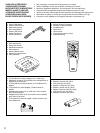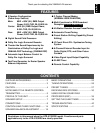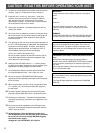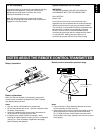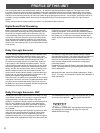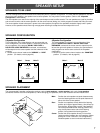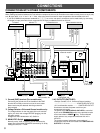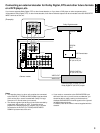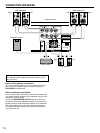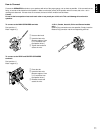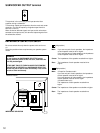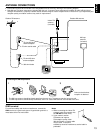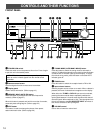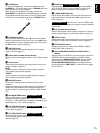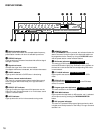
3
English
● 5 Speaker Configuration
(Power Amp. Section)
Main: 60W + 60W (8Ω) RMS Output
Power, 0.04% THD, 20–20,000 Hz
Center: 60W (8Ω) RMS Output Power,
0.04% THD, 20–20,000 Hz
Rear: 60W + 60W (8Ω) RMS Output
Power, 0.04% THD, 20–20,000 Hz
● Digital Sound Field Processor
● Dolby Pro Logic Surround Decoder
● Theater-like Sound Experience by the
Combination of Dolby Pro Logic and
YAMAHA DSP Technology (CINEMA DSP)
● Automatic Input Balance Control for
Dolby Pro Logic Surround
● Test Tone Generator for Easier Speaker
Balance Adjustment
Thank you for selecting this YAMAHA AV receiver.
SUPPLIED ACCESSORIES............................ 2
FEATURES ..................................................... 3
CAUTION ........................................................ 4
NOTES ABOUT THE REMOTE CONTROL
TRANSMITTER............................................... 5
PROFILE OF THIS UNIT ................................ 6
SPEAKER SETUP .......................................... 7
CONNECTIONS.............................................. 8
CONTROLS AND THEIR FUNCTIONS ........ 14
SPEAKER BALANCE ADJUSTMENT .......... 19
FEATURES
CONTENTS
Illustrations in this manual show the HTR-5130RDS model. Functions and parts
applicable only to the HTR-5130RDS are clearly specified.
● 3 Center Channel Modes
(NORMAL/WIDE/PHANTOM)
● Multi-Functions for RDS Broadcast
Reception HTR-5130RDS only
● 40-Station Random Access Preset Tuning
● Automatic Preset Tuning
● Preset Station Shifting Capability (Preset
Editing)
● IF Count Direct PLL Synthesizer Tuning
System
● 6-Channel External Decoder Input for
Dolby Digital, DTS, and Other Future
Formats
● Video Signal Input/Output Capability
● SLEEP Timer
● Remote Control Capability
BASIC OPERATIONS ................................... 22
TUNING OPERATIONS ................................ 26
PRESET TUNING ......................................... 27
RECEIVING RDS STATIONS ....................... 30
USING DIGITAL SOUND FIELD
PROCESSOR (DSP) .................................... 35
SETTING THE SLEEP TIMER ...................... 39
TROUBLESHOOTING .................................. 40
SPECIFICATIONS ........................................ 41




